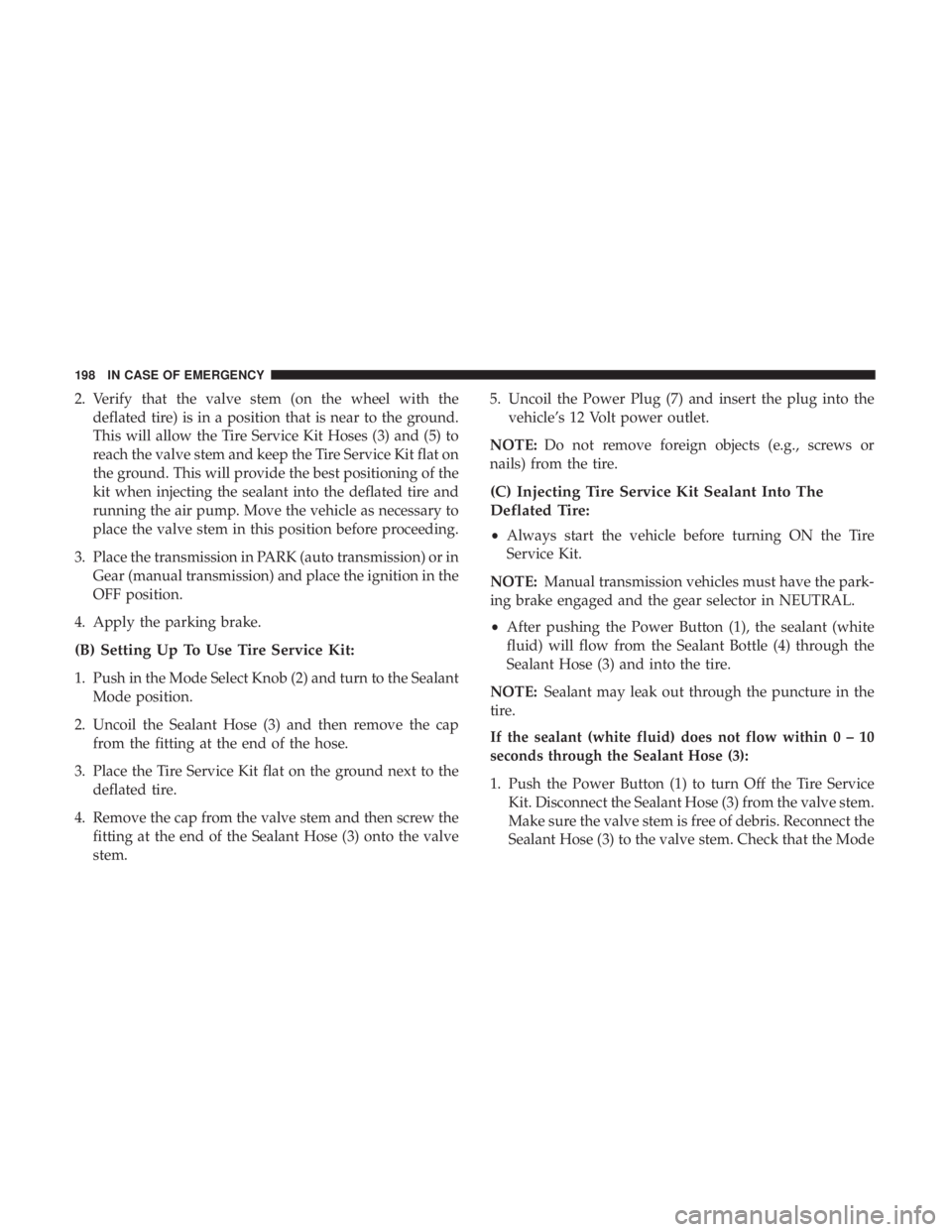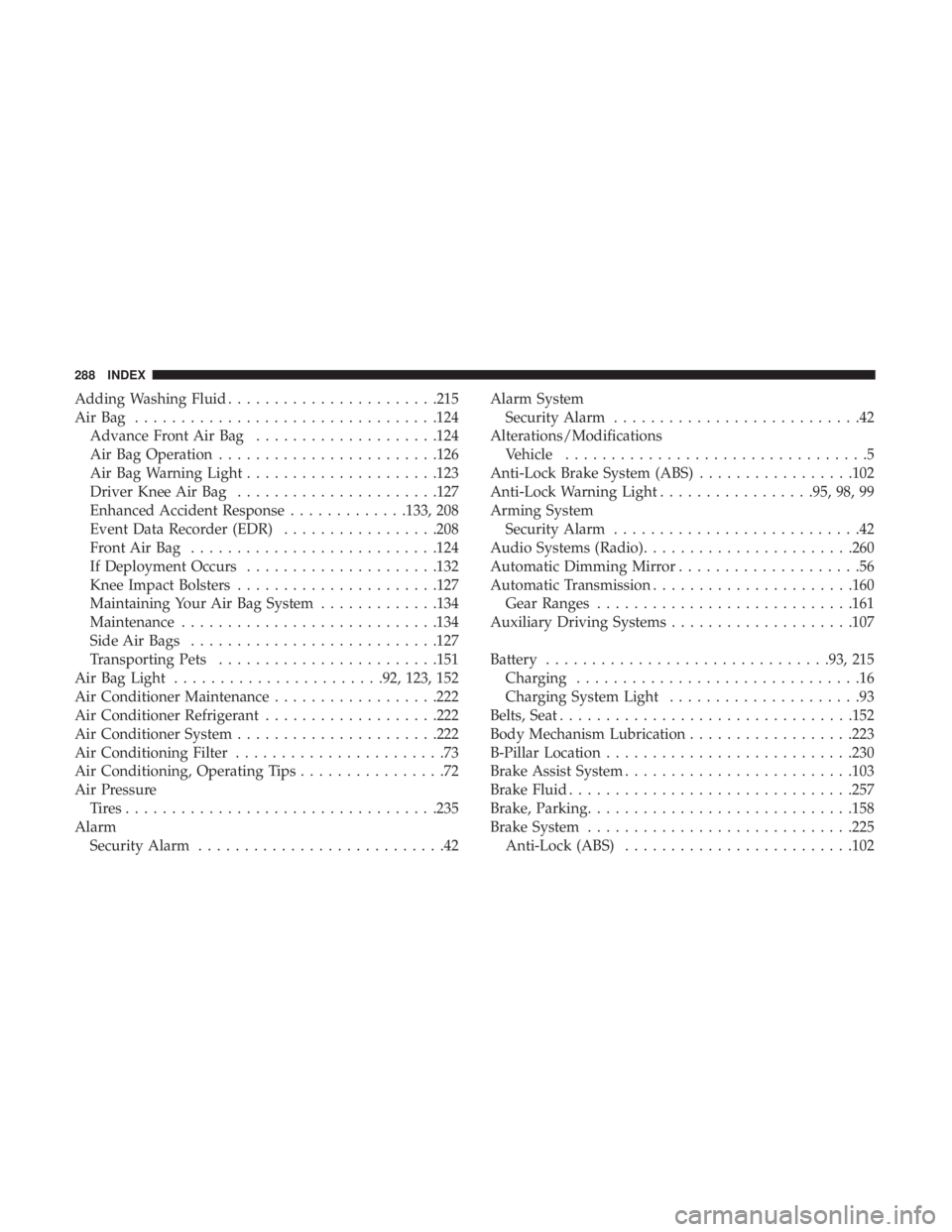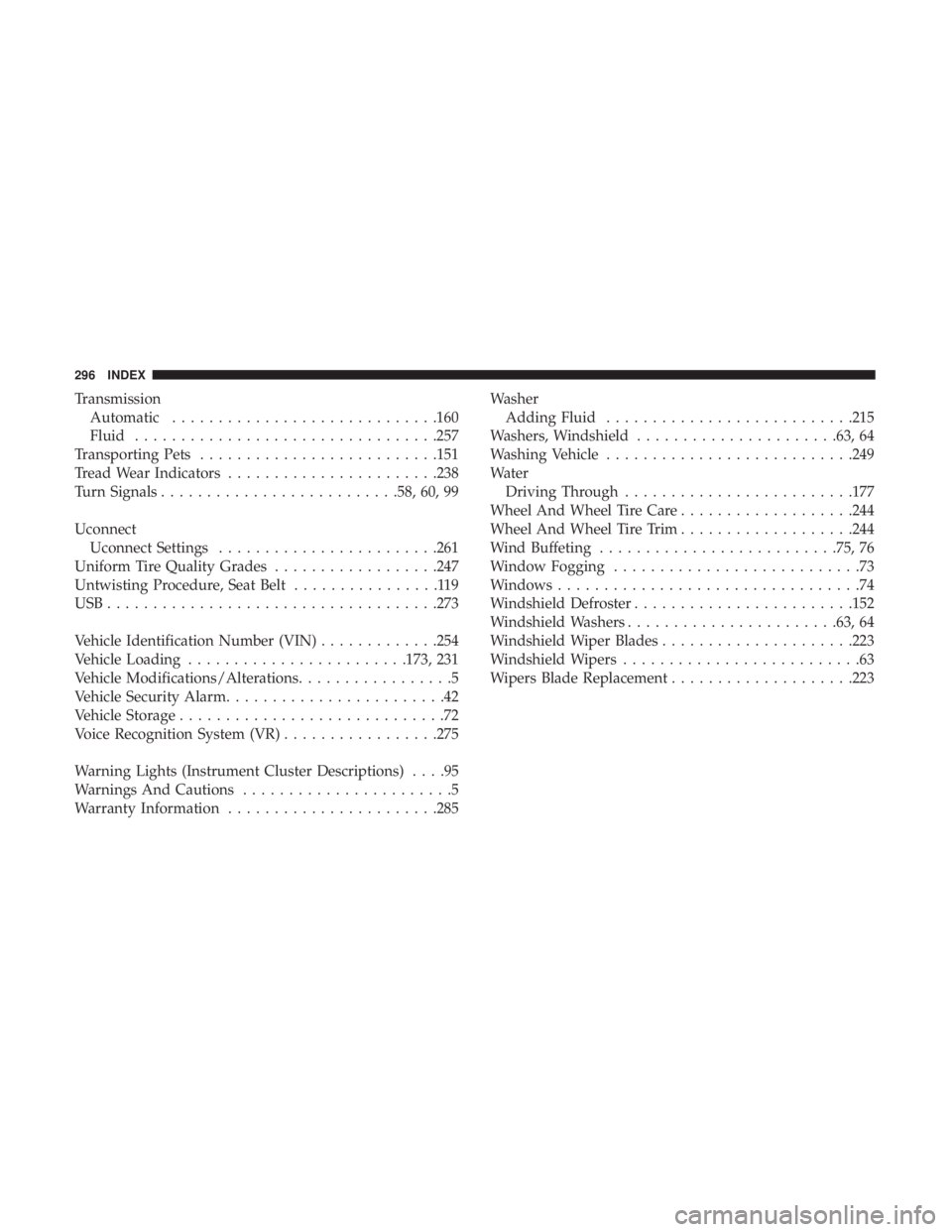2019 FIAT 500E transmission fluid
[x] Cancel search: transmission fluidPage 21 of 300

E-Park is activated when the driver pushes the PARK
button. An electric motor activates the parking pawl and
locks the single-speed transmission when the vehicle is
placed into PARK. This will prevent any unwanted move-
ment of the vehicle.
NOTE:The engagement of the E-Park can be heard when
there is no noise in the interior of the vehicle, this is a
normal condition.
Climate Control (HVAC System)
Your 500e is equipped with an Automatic Temperature
Control (ATC) HVAC system. This HVAC system utilizes a
humidity sensor, cabin sensor, and ambient temperature
sensor to choose operation mode and control cabin com-
fort. These components allow the controller to operate the
HVAC system in a very efficient manner to maximize
driving range.
Your 500e also uses an electric air heater to provide heat to
the cabin.
Electric Air Conditioning Compressor
Your 500e uses an electric air conditioning compressor. The
air conditioning compressor is powered by the high volt-
age battery system and is used to cool the vehicle occu-
pants and the high voltage battery while the vehicle is
being driven or when it is being charged.
The high voltage battery may require cooling to keep the
vehicle running. The air conditioning compressor activates
without any input from the occupant.
NOTE: The AC system helps cool the high voltage battery.
If the air conditioning system should require service, see an
authorized dealer as soon as possible.
Electric Power Steering
Your vehicle is equipped with an Electric Power Steering
(EPS) system. The power steering system requires no
maintenance and operates without the use of power steer-
ing fluid.
3
GETTING TO KNOW YOUR VEHICLE 19
Page 179 of 300

•Keep tires properly inflated.
• Maintain sufficient distance between your vehicle and
the vehicle in front of you to avoid a collision in a
sudden stop.
Driving Through Water
Driving through water more than a few inches/centimeters
deep will require extra caution to ensure safety and pre-
vent damage to your vehicle.
Flowing/Rising Water
WARNING!
Do not drive on or across a road or path where water is
flowing and/or rising (as in storm run-off). Flowing
water can wear away the road or path’s surface and
cause your vehicle to sink into deeper water. Further-
more, flowing and/or rising water can carry your ve-
hicle away swiftly. Failure to follow this warning may
result in injuries that are serious or fatal to you, your
passengers, and others around you.
Shallow Standing Water
Although your vehicle is capable of driving through shal-
low standing water, consider the following Caution and
Warning before doing so.
CAUTION!
• Always check the depth of the standing water before
driving through it. Never drive through standing
water that is deeper than the bottom of the tire rims
mounted on the vehicle.
• Determine the condition of the road or the path that
is under water and if there are any obstacles in the
way before driving through the standing water.
• Do not exceed 5 mph (8 km/h) when driving through
standing water. This will minimize wave effects.
• Driving through standing water may cause damage
to your vehicle’s drivetrain components. Always in-
spect your vehicle’s fluids (i.e., transmission, coolant,
etc.) for signs of contamination (i.e., fluid that is
milky or foamy in appearance) after driving through
standing water. Do not continue to operate the ve-
hicle if any fluid appears contaminated, as this may
(Continued)
6
STARTING AND OPERATING 177
Page 200 of 300

2. Verify that the valve stem (on the wheel with thedeflated tire) is in a position that is near to the ground.
This will allow the Tire Service Kit Hoses (3) and (5) to
reach the valve stem and keep the Tire Service Kit flat on
the ground. This will provide the best positioning of the
kit when injecting the sealant into the deflated tire and
running the air pump. Move the vehicle as necessary to
place the valve stem in this position before proceeding.
3. Place the transmission in PARK (auto transmission) or in Gear (manual transmission) and place the ignition in the
OFF position.
4. Apply the parking brake.
(B) Setting Up To Use Tire Service Kit:
1. Push in the Mode Select Knob (2) and turn to the Sealant Mode position.
2. Uncoil the Sealant Hose (3) and then remove the cap from the fitting at the end of the hose.
3. Place the Tire Service Kit flat on the ground next to the deflated tire.
4. Remove the cap from the valve stem and then screw the fitting at the end of the Sealant Hose (3) onto the valve
stem. 5. Uncoil the Power Plug (7) and insert the plug into the
vehicle’s 12 Volt power outlet.
NOTE: Do not remove foreign objects (e.g., screws or
nails) from the tire.
(C) Injecting Tire Service Kit Sealant Into The
Deflated Tire:
• Always start the vehicle before turning ON the Tire
Service Kit.
NOTE: Manual transmission vehicles must have the park-
ing brake engaged and the gear selector in NEUTRAL.
• After pushing the Power Button (1), the sealant (white
fluid) will flow from the Sealant Bottle (4) through the
Sealant Hose (3) and into the tire.
NOTE: Sealant may leak out through the puncture in the
tire.
If the sealant (white fluid) does not flow within0–10
seconds through the Sealant Hose (3):
1. Push the Power Button (1) to turn Off the Tire Service Kit. Disconnect the Sealant Hose (3) from the valve stem.
Make sure the valve stem is free of debris. Reconnect the
Sealant Hose (3) to the valve stem. Check that the Mode
198 IN CASE OF EMERGENCY
Page 258 of 300

Tighten the lug nuts/bolts in a star pattern until each
nut/bolt has been tightened twice.After 25 miles (40 km), check the lug nut/bolt torque to be
sure that all the lug nuts/bolts are properly seated against
the wheel.
WARNING!
To avoid the risk of forcing the vehicle off the jack, do
not tighten the lug nuts/bolts fully until the vehicle has
been lowered. Failure to follow this warning may
result in personal injury.
FLUID CAPACITIES
Systems
U.S.Metric
Power Electronics Cooling System 3.6 Quarts3.4 Liters
Battery Thermal Management Cooling System 7.0 Quarts6.6 Liters
Single-Speed Transmission 0.8 Quart750 ml
Torque Patterns
256 TECHNICAL SPECIFICATIONS
Page 259 of 300

FLUIDS AND LUBRICANTS
ComponentFluids And Lubricants
Coolant Mopar Antifreeze/Coolant 10 Year/150,000 Mile (240,000 km)
Formula OAT (Organic Additive Technology) or equivalent
meeting the requirements of FCA Material Standard MS.90032.
Brake Master Cylinder Mopar DOT 3, SAE J1703 should be used. Refrigerant Mopar R134a
Compressor Lubricant Mopar POE Oil or Equivalent meeting the requirements of FCA
Material Standard MS-12727
Single-Speed Transmission Castrol BOT 533
CAUTION!
•Mixing of coolant (antifreeze) other than specified
Organic Additive Technology (OAT) coolant (anti-
freeze), may result in cooling system damage and
may decrease corrosion protection. Organic Additive
Technology (OAT) coolant is different and should
not be mixed with Hybrid Organic Additive Tech-
nology (HOAT) coolant (antifreeze). If a non-OAT
coolant (antifreeze) is introduced into the cooling
system in an emergency, it should be replaced with
the specified coolant (antifreeze) as soon as possible.
(Continued)
CAUTION! (Continued)
•Do not use water alone or alcohol-based coolant
(antifreeze) products. Do not use additional rust
inhibitors or antirust products, as they may not be
compatible with the radiator coolant and may plug
the radiator.
• This vehicle has not been designed for use with
propylene glycol-based coolant (antifreeze). Use of
propylene glycol-based coolant (antifreeze) is not
recommended.9
TECHNICAL SPECIFICATIONS 257
Page 290 of 300

Adding Washing Fluid...................... .215
AirBag ................................ .124
Advance Front Air Bag ....................124
Air Bag Operation ....................... .126
Air Bag Warning Light .....................123
Driver Knee Air Bag ..................... .127
Enhanced Accident Response .............133, 208
Event Data Recorder (EDR) .................208
FrontAirBag .......................... .124
If Deployment Occurs .....................132
Knee Impact Bolsters ..................... .127
Maintaining Your Air Bag System .............134
Maintenance ........................... .134
Side Air Bags .......................... .127
Transporting Pets ....................... .151
Air Bag Light ...................... .92, 123, 152
Air Conditioner Maintenance ..................222
Air Conditioner Refrigerant ...................222
Air Conditioner System ..................... .222
Air Conditioning Filter .......................73
Air Conditioning, Operating Tips ................72
Air Pressure Tires................................. .235
Alarm Security Alarm ...........................42 Alarm System
Security Alarm ...........................42
Alterations/Modifications Vehicle .................................5
Anti-Lock Brake System (ABS) .................102
Anti-Lock Warning Light .................95, 98, 99
Arming System Security Alarm ...........................42
Audio Systems (Radio) ...................... .260
Automatic Dimming Mirror ....................56
Automatic Transmission ..................... .160
Gear Ranges ........................... .161
Auxiliary Driving Systems ....................107
Battery .............................. .93, 215
Charging ...............................16
Charging System Light .....................93
Belts, Seat ............................... .152
Body
Mechanism Lubrication ..................223
B-Pillar Location .......................... .230
Brake Assist System ........................ .103
Brake Fluid .............................. .257
Brake, Parking ............................ .158
Brake System ............................ .225
Anti-Lock (ABS) ........................ .102
288 INDEX
Page 298 of 300

TransmissionAutomatic ............................ .160
Fluid ................................ .257
Transporting Pets ......................... .151
Tread Wear Indicators ...................... .238
Turn Signals ......................... .58, 60, 99
Uconnect Uconnect Settings ....................... .261
Uniform Tire Quality Grades ..................247
Untwisting Procedure, Seat Belt ................119
USB................................... .273
Vehicle Identification Number (VIN) .............254
Vehicle Loading ....................... .173, 231
Vehicle Modifications/Alterations .................5
Vehicle Security Alarm ........................42
Vehicle Storage .............................72
Voice Recognition System (VR) .................275
Warning Lights (Instrument Cluster Descriptions) ....95
Warnings And Cautions .......................5
Warranty Information ...................... .285Washer
Adding Fluid .......................... .215
Washers, Windshield ..................... .63, 64
Washing Vehicle .......................... .249
Water Driving Through ........................ .177
Wheel And Wheel Tire Care ...................244
Wheel And Wheel Tire Trim ...................244
Wind Buffeting ......................... .75, 76
Window Fogging ...........................73
Windows .................................74
Windshield Defroster ....................... .152
Windshield Washers ...................... .63, 64
Windshield Wiper Blades .....................223
Windshield Wipers ..........................63
Wipers Blade Replacement ....................223
296 INDEX